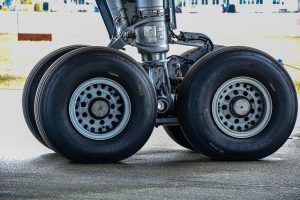 Tires are an essential component of an airplane’s landing system. Airplanes can’t land on the belly of their fuselage. Rather, they must land on inflated tires that can withstand both the weight of the airplane and the friction it creates on the runway. Some airplanes contain four or six tires, whereas others contain up to 10 tires. With tires, airplanes can safely take off and land.
Tires are an essential component of an airplane’s landing system. Airplanes can’t land on the belly of their fuselage. Rather, they must land on inflated tires that can withstand both the weight of the airplane and the friction it creates on the runway. Some airplanes contain four or six tires, whereas others contain up to 10 tires. With tires, airplanes can safely take off and land.
With that said, airplanes don’t use the same rubber tires as cars, trucks and other road vehicles. They may look similar, but airplane tires are made of a special type of rubber that’s not found in automotive tires. Known as conductive rubber, this alternative material distinguishes airplane tires from automotive tires. So, why are airplane tires made of conductive rubber instead of traditional rubber?
What Is Conductive Rubber?
Conductive rubber is an elastic rubber-based material that’s designed specifically to conduct electricity. Also known as conductive elastomer, electricity can flow through it with minimal restriction. Conductivity, of course, is a measurement of how well electricity can flow through a material or object. Some materials high excellent conductivity, whereas others have poor conductivity. Conductive rubber is simply any type of rubber-based material through which electricity can easily flow.
The Reason Airplanes Use Conductive-Rubber Tires
Airplanes use tires made of conductive rubber to neutralize electricity. Electricity is created naturally through friction — and airplane tires are exposed to a lot of friction during takeoffs and landings. The friction between an airplane’s tires and the runway can lead to a buildup of electricity. When taking off, an airplane’s tires may accumulate electricity that can damage the airplane’s electronic components.
Airplanes contain hundreds if not thousands of electrical components, many of which are highly sensitive to electrical discharge. If a stray electrical charge reaches one of these components, the component may fail. The use of conductive rubber tires prevents this from happening.
Even though conductive rubber allows electricity to flow through it, it prevents the buildup of electricity. With conductive rubber tires, electricity will travel to the ground rather than accumulating in the tires. The friction-created electricity won’t build up in the airplane’s tires. When made of conductive rubber, the tires will expel it to the ground.
In Conclusion
Conductive rubber is the preferred choice of material used in the production of airplane tires. It features the same force-absorbing properties as traditional rubber but with the added benefit of conductivity. Conductive rubber tires protect an airplane’s electronics from damage caused by electrical discharge.



